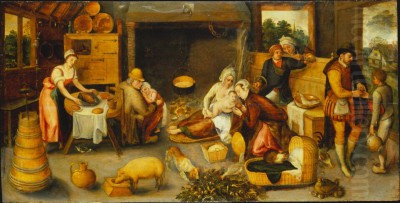
Marten van Cleve the Elder stands as a significant yet often underestimated figure in the rich tapestry of 16th-century Flemish painting. Active during a period of immense artistic innovation and profound social upheaval, Van Cleve carved a niche for himself as a keen observer and vibrant depictor of rural life. Working in the bustling artistic hub of Antwerp, he navigated the powerful influence of his contemporary, Pieter Bruegel the Elder, while developing a distinct artistic voice that resonated with patrons and influenced subsequent generations of artists, particularly within the Bruegel dynasty itself. His oeuvre, primarily focused on peasant kermesses, weddings, and daily activities, offers a valuable window into the customs, celebrations, and hardships of the common folk in the Southern Netherlands.
Origins and Artistic Formation
Marten van Cleve the Elder was born in Antwerp around 1527. His family, originally from the Duchy of Cleves (Kleve), had established itself within the artistic community of Antwerp. His father, Willem van Cleve the Elder, was a painter, suggesting Marten was immersed in the world of art from a young age. This familial connection to the craft likely provided his initial exposure and perhaps rudimentary training. His elder brother, Hendrick van Cleve III (c. 1525–c. 1590/95), also became a respected painter, known primarily for his landscapes and topographical views, sometimes incorporating fantastical or biblical elements.
Formal training for Marten likely began under his brother Hendrick, documented between 1553 and 1556. Hendrick's focus on landscape may have imparted skills in setting and perspective, although Marten's primary interest would soon shift towards figure painting and genre scenes. Some art historians also posit that Marten spent time in the workshop of Frans Floris (c. 1519/20–1570), one of Antwerp's leading painters and a key figure in introducing Italianate Renaissance styles to the North. Floris ran a large, highly organized workshop, and exposure to its methods and diverse output could have significantly broadened Marten's artistic horizons, even if he ultimately diverged from Floris's more classically inspired history painting.
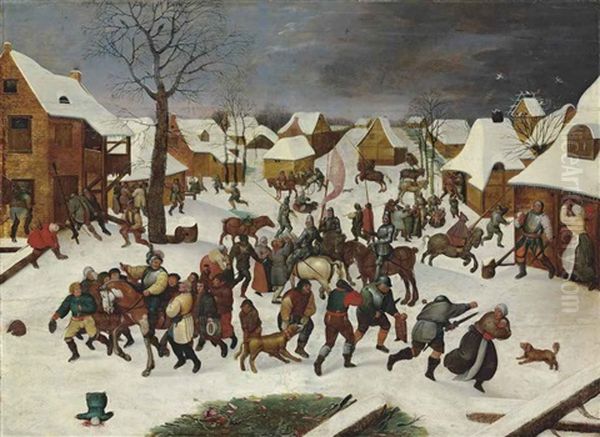
A pivotal moment in Marten van Cleve's early career occurred in 1551 or 1552 when he was registered as a master in the prestigious Antwerp Guild of Saint Luke. This professional recognition granted him the right to establish his own workshop and take on apprentices. Notably, he achieved this status in the same year as Pieter Bruegel the Elder (c. 1525/30–1569), the artist whose work would become inextricably linked with Van Cleve's own artistic journey. Their near-contemporaneous entry into the guild underscores their shared professional milieu, even if direct evidence of close personal collaboration remains elusive.
Antwerp: A Crucible of Art and Conflict
To fully appreciate Marten van Cleve's career, one must understand the environment of 16th-century Antwerp. During his lifetime, the city was one of Europe's most important economic and cultural centers. Its bustling port facilitated international trade, bringing immense wealth and a cosmopolitan population. This prosperity fueled a vibrant art market, supporting numerous painters, sculptors, printmakers, and dealers. The Guild of Saint Luke played a crucial role in regulating this market, maintaining standards, and fostering a sense of community among artists.
However, this golden age was also marked by profound instability. The Protestant Reformation gained traction in the Low Countries, leading to religious tensions and conflict with the ruling Catholic Habsburg authorities, particularly under Philip II of Spain. These tensions erupted violently during the Iconoclastic Fury (Beeldenstorm) of 1566, when Protestant mobs destroyed religious images in churches across the region, including Antwerp. This event signaled the beginning of the Dutch Revolt, a long and bloody struggle for independence and religious freedom.
Antwerp found itself at the heart of this conflict. The city experienced periods of Calvinist rule followed by harsh Spanish reprisals. The infamous Spanish Fury of 1576 saw mutinous Spanish troops sack the city, massacring thousands of citizens and burning large parts of it, including the town hall. Marten van Cleve lived and worked through these tumultuous decades. While his paintings often depict scenes of merriment and everyday life, the underlying social and political anxieties of the era sometimes surface, particularly in works like The Massacre of the Innocents, which could be interpreted as an allegory for contemporary suffering under Spanish rule. The demand for seemingly apolitical genre scenes might also reflect a desire among patrons for escapism or a focus on local identity amidst widespread turmoil.
The Workshop and Artistic Production
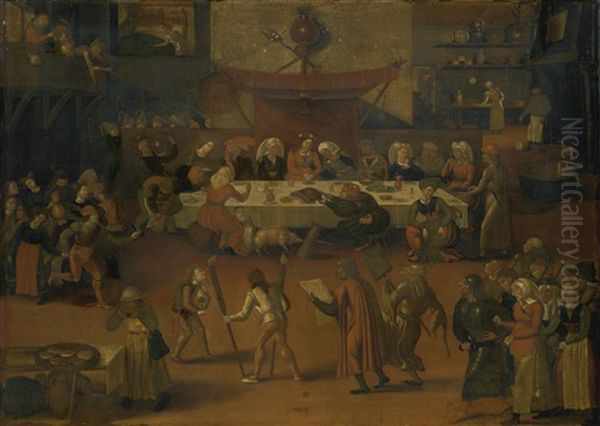
Following his acceptance into the Guild, Marten van Cleve established his own workshop around 1556. It quickly gained a reputation for producing lively and engaging genre scenes. During the 1560s and 1570s, his workshop was highly productive, catering to a growing demand for paintings depicting peasant life. Like many successful masters of the time, Van Cleve likely employed assistants and apprentices to help meet this demand. Records indicate he had at least five registered pupils, some noted as coming from the Liège region.
A key aspect of workshop practice in this era was the production of replicas and variations of successful compositions. Marten van Cleve's workshop was no exception. Popular themes, such as peasant weddings or kermesses, were often repeated with minor alterations to satisfy different clients. This practice explains the existence of multiple versions of certain compositions attributed to Van Cleve or his workshop. While this sometimes complicates attribution, it also attests to the popularity and commercial success of his artistic formulas.
His family played a role in his artistic enterprise. His four sons – Gillis, Marten the Younger, Joris, and Nicolaas – are believed to have trained and worked in his studio, continuing the family's artistic legacy, though their individual contributions are often difficult to distinguish from the workshop's output. This familial involvement was common in Antwerp's artistic dynasties, ensuring the transmission of skills and styles across generations. Marten van Cleve married Maria de Greve on February 7, 1556 (though some sources state 1571, the earlier date seems more likely given his workshop establishment), and they had several children, solidifying his place within the social fabric of Antwerp.
Artistic Style: Realism, Color, and Character
Marten van Cleve's artistic identity is firmly rooted in the genre painting tradition that flourished in the Southern Netherlands during the 16th century. He specialized in depicting the lives of the rural population, capturing their celebrations, labours, and interactions with keen observation and often a touch of humour. His primary subjects included peasant weddings (boerenbruiloft), village fairs or kermesses, dances, tavern scenes, and seasonal activities. This focus aligned him with contemporaries like Pieter Aertsen (c. 1508–1575) and Joachim Beuckelaer (c. 1533–c. 1575), who specialized in market and kitchen scenes, collectively broadening the scope of everyday life as a subject for art.
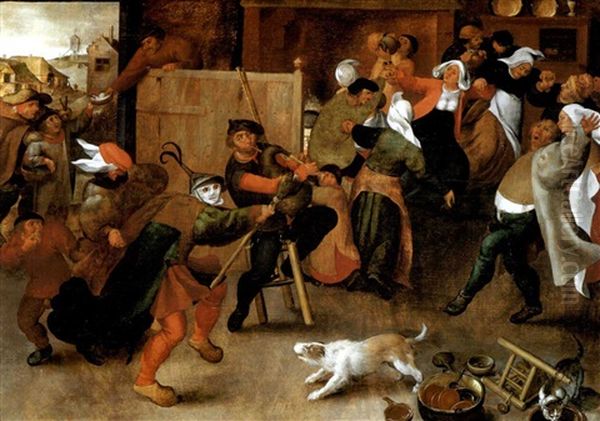
While deeply influenced by Pieter Bruegel the Elder, Van Cleve developed recognizable stylistic traits. His colour palette often tends towards warmer tones compared to the sometimes cooler, more earth-toned palettes of Bruegel. He demonstrated a particular skill in rendering the folds and curves of clothing, giving his figures a sense of volume and movement. His compositions are typically bustling with activity, featuring numerous figures engaged in various pursuits within a well-defined, often high-viewpoint, landscape or village setting.
Van Cleve populated his scenes with robust, energetic figures. While not always idealized, they possess a lively characterization. Specific details often distinguish his work: scholars have noted the tendency for female figures in his paintings to wear larger, more elaborate headdresses than those depicted by Bruegel. The frequent inclusion of dogs, often participating in the scene's activity, is another characteristic feature, almost a signature motif. He also showed a fondness for depicting children's games, integrating them naturally into the broader communal scenes. This attention to specific, recurring details helps art historians identify his hand and differentiate his work from that of his numerous followers and imitators.
The Bruegel Connection: Influence and Independence
The relationship between Marten van Cleve and Pieter Bruegel the Elder is central to understanding Van Cleve's place in art history. As contemporaries admitted to the Guild in the same year, they undoubtedly knew of each other's work. Bruegel's innovative and powerful depictions of peasant life set a new standard, and Van Cleve clearly absorbed lessons from his slightly older and ultimately more famous colleague. Shared themes like the peasant wedding, the kermesse, and various proverbs or moralizing scenes are evident in both artists' outputs.
However, Van Cleve was far more than a mere imitator. While Bruegel often imbued his peasant scenes with profound moral commentary or complex allegories, Van Cleve's approach generally appears more straightforwardly descriptive and celebratory, though subtle social commentary or political allegory cannot be entirely ruled out. He developed his own compositional formulas and character types. His figures, while robust, sometimes lack the monumental, almost sculptural quality of Bruegel's peasants, possessing instead a more fluid, dynamic energy.
Crucially, Van Cleve outlived Bruegel by twelve years (Bruegel died in 1569, Van Cleve in 1581). This extended period allowed him to continue developing his style and workshop production, solidifying his position as a leading exponent of the Bruegelian tradition after the master's death. His workshop became a primary source for paintings in the Bruegelian vein, satisfying a market hungry for such scenes. This role directly influenced the next generation, particularly Bruegel's own sons.
Representative Works and Thematic Concerns
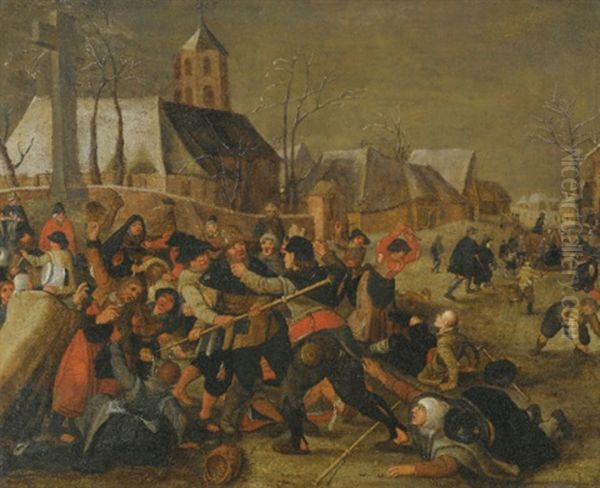
While a definitive catalogue raisonné remains challenging due to workshop practices and attribution issues, several key works exemplify Marten van Cleve's style and thematic preoccupations.
The Massacre of the Innocents: Several versions of this subject exist, attributed to Van Cleve or his workshop. While a biblical theme, its depiction often carried contemporary resonance in the war-torn Netherlands. The setting is typically a Flemish village under heavy snow, where soldiers, often depicted in contemporary attire, brutally carry out Herod's orders. Many scholars interpret these scenes as veiled condemnations of the atrocities committed by Spanish troops against the civilian population during the Dutch Revolt. The juxtaposition of violence with the ordinary setting heightens the sense of tragedy and injustice.
Peasant Wedding Feast: This was one of Van Cleve's most popular subjects, produced in numerous variations by his workshop. Typically set indoors in a barn or large room, or outdoors under trees, these paintings depict the boisterous celebrations surrounding a rural marriage. Figures are shown eating, drinking, dancing, playing music, and presenting gifts. Van Cleve captures the energy and communal spirit of the event, often including humorous details and interactions among the guests. These works provide valuable insights into marriage customs and social life in the period.
Kermesse Scenes (Village Fairs): Alongside weddings, kermesses were a favourite theme. These annual village fairs, often held on a patron saint's day (like the Feast of Saint George), were occasions for feasting, dancing, drinking, commerce, and general revelry. Van Cleve's depictions are typically panoramic, filled with crowds engaged in diverse activities – from solemn processions to drunken brawls, from market stalls to impromptu dances. They showcase his ability to organize complex compositions and capture the vibrant, sometimes chaotic, atmosphere of these communal gatherings.
Other Genre Scenes: Van Cleve's repertoire also included depictions of seasonal farm work, tavern interiors, children's games, and allegorical scenes often based on proverbs, reflecting the broader interest in moralizing genre popularised by Bruegel and earlier artists like Hieronymus Bosch (c. 1450–1516).
Collaborations in the Antwerp Art World
Collaboration between artists specializing in different areas was a common and efficient practice in 16th-century Antwerp. Figure painters often teamed up with landscape or architectural specialists to create richer, more complex works. Marten van Cleve participated in this collaborative network.
His most documented collaborations were with the landscape painter Jacob Grimmer (c. 1525/26–before May 1590). Grimmer was known for his atmospheric and often idyllic depictions of the Flemish countryside, frequently organized into series representing the months or seasons. Van Cleve would add the 'staffage' – the human figures and animals – animating Grimmer's landscapes. Examples include paintings representing 'Spring' or 'Winter', where Van Cleve's characteristic figures populate Grimmer's settings. This partnership combined Grimmer's skill in landscape with Van Cleve's popular genre figures, creating works that appealed to a broad market.
This network of collaboration also included artists like Gillis Mostaert (c. 1528–1598), another figure and genre painter who sometimes collaborated with landscape artists. The Antwerp art scene was a tightly knit community where artists shared influences, workshop space, and sometimes commissions. This environment fostered both competition and cooperation, driving innovation and stylistic development. Other prominent Antwerp artists of the era, such as the portraitist Anthonis Mor (c. 1517–1577) or the aforementioned Frans Floris and history painter Maerten de Vos (1532–1603), contributed to the city's diverse artistic output, though Van Cleve remained firmly focused on his chosen specialty of genre painting.
Later Years and Demise
Marten van Cleve continued to run his successful workshop through the 1570s, a decade marked by intense conflict in Antwerp, culminating in the Spanish Fury of 1576. Despite the turmoil, the demand for his paintings seems to have persisted. His marriage to Maria de Greve provided a stable family life amidst the chaos.
His productive career was cut short by illness. Contemporary sources, including the early art historian Karel van Mander (writing in 1604), state that Marten van Cleve suffered severely from gout, a painful condition affecting the joints. This affliction likely hampered his ability to paint in his final years. He died in Antwerp in 1581, aged around 54. An inventory of his estate was drawn up shortly after his death, confirming his passing in that year and providing insights into his possessions and the state of his workshop. The earlier date of 1570 sometimes cited for his death appears to be erroneous, contradicted by guild records and the inventory documentation.
Legacy and Enduring Influence
Marten van Cleve the Elder's death did not mark the end of his influence. His workshop traditions were carried on by his sons, ensuring the continued production of paintings in his style. More significantly, his compositions and thematic innovations had a profound impact on the next generation of Flemish genre painters, most notably Pieter Brueghel the Younger (1564/65–1637/38).
Pieter Brueghel the Younger, along with his brother Jan Brueghel the Elder (1568–1625), inherited their father's artistic legacy but also drew heavily on other sources available in Antwerp. Marten van Cleve's works provided a rich repository of compositions and motifs. Many paintings by Pieter Brueghel the Younger, particularly his numerous peasant weddings and kermesses, are now understood to be adaptations or direct copies of lost or existing prototypes by Marten van Cleve. For a long time, some of Van Cleve's original compositions were even misattributed to the younger Brueghel, highlighting the close stylistic connection and Van Cleve's role as a key source for the Brueghel workshop's production line.
Van Cleve's influence extended beyond the immediate Bruegel circle. His popularization of peasant genre themes contributed to their enduring appeal throughout the late 16th and 17th centuries. Artists like David Vinckboons (1576–c. 1632), who worked in both Antwerp and Amsterdam, and later masters of Flemish genre painting such as Adriaen Brouwer (1605/06–1638) and David Teniers the Younger (1610–1690), built upon the foundations laid by Bruegel and Van Cleve, further developing the depiction of everyday life with increasing naturalism and psychological depth. Even the earlier Antwerp master Joos van Cleve (c. 1485–1540/41), likely a relative though representing an earlier stylistic phase focused more on religious themes and portraiture, forms part of the broader family context within which Marten emerged.
In conclusion, Marten van Cleve the Elder was more than just a follower of Pieter Bruegel the Elder. He was a talented and successful artist in his own right, a master organizer of a productive workshop, and a key figure in popularizing and disseminating genre painting focused on peasant life. His lively compositions, warm colours, and characteristic figure types created a distinct artistic identity. While perhaps overshadowed by the towering genius of Bruegel, Van Cleve played a crucial role in bridging the gap between Bruegel and the subsequent generation, particularly influencing Pieter Brueghel the Younger and ensuring the vitality of the Bruegelian tradition well into the 17th century. His works remain valuable not only for their artistic merit but also as vibrant historical documents of Flemish culture during a transformative era.